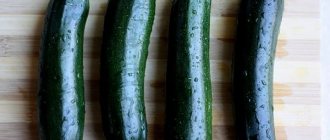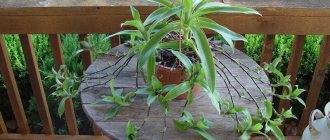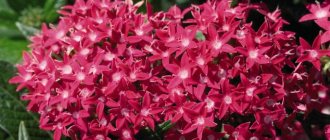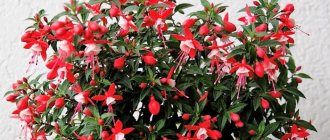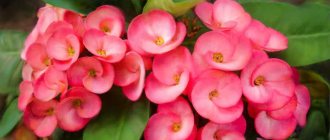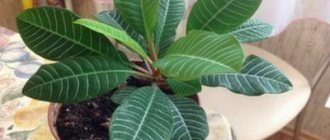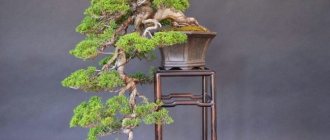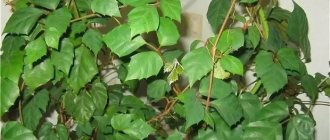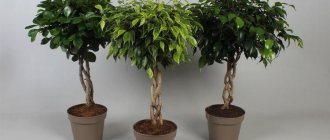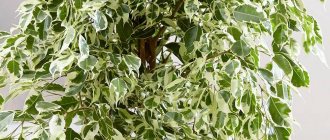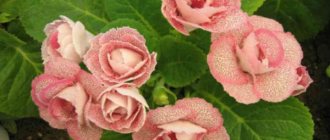Photo Oleander (Nerium oleandr) is an evergreen shrub from the Kutrovaceae family. The plant appeared in the subtropics of the Mediterranean. Its close relatives are herbaceous plants, parasitic vines and giant tropical trees. In the wild it is found in the form of tall (up to 4 m) powerful bushes in the river valleys of Asia Minor, in the Caucasus Mountains, and grows in Algeria and Italy. There is only one cultivated form of this plant, and it is called “common” oleander! They are grown in open ground and used in landscape design on the Black Sea coast and in the Crimea.
In areas located to the north, the plant is grown in greenhouses and at home. Oleander grows quickly, growing 30 cm per year. At home it can grow more than 2 meters if the growth is not limited by pruning. It usually lives in an apartment for up to 15 years, but if the bush is rejuvenated and properly cared for, it can live longer. Flowering continues from July to October. On the shoots, large bright flowers are adjacent to unopened buds, so it seems that it is blooming constantly.
| Grows quickly, up to 30 cm per year. |
| Blooms from mid-summer to mid-autumn. |
| The plant is easy to grow. |
| Perennial. |
What does an oleander flower look like (description of the plant)
Oleander belongs to the Kutrov family. The Latin name “nerium” most likely comes from the Greek word “neros” - “raw”, which may be due to the fact that the plant prefers to grow closer to water; its thickets in nature often frame river beds.
In our country it grows along the entire Black Sea coast, in the Caucasus and in the Krasnodar Territory.
Close relatives of oleander are woody succulents from the Kutrov family, popular among gardeners - adenium and pachypodium.
It is an evergreen shrub with narrow leaves of gray-green color. Reaches a height of 7-10 meters under favorable conditions. The flowers are double or simple, collected in lush, dense inflorescences at the ends of the branches.
In nature, the most common colors of oleander flowers are white and pink (from pale to dark), less often purple-red and creamy yellow. The fruit looks like a dried pod, reaches a length of 10 cm, and contains seeds with fluffy tufts.
Flowering of oleanders begins in early June. Under favorable conditions, the plant blooms until late autumn.
Description
The oleander flower, a photo of which is given in the material, is a prominent representative of the Kutrovye family. In its natural environment, this perennial evergreen shrub is found in the subtropics of southern Europe, North Africa, China and Japan. The culture prefers moist soil and often grows on the banks of reservoirs, and also occupies the beds of drying up rivers.
Depending on the variety, the height of the bush reaches from 1.5 to 3 meters. Therefore, luxurious oleander flowers should not be grown if you have a modest-sized apartment. The tropical beauty becomes especially attractive from June to September. At this time, the shoots are densely covered with large flowers. The petals are painted in red, yellow, and white tones, but soft pink oleanders are also found.
Depending on the variety, the buds are simple or double. The flowers emit a strong, pleasant aroma. But for some, this smell causes headaches. Therefore, during flowering it is not recommended to keep the plant indoors. It is better to take it out into the garden or onto the balcony.
Some people are afraid to grow oleander at home, because the tropical beauty is a poisonous plant. In fact, everything is not so scary: you can get poisoned if you eat a few leaves of the flower. And it’s unlikely that anyone in their right mind would do this. However, the plant should not be kept in an apartment where there is a small child or pets. And also during care, especially pruning, it is advisable to wear rubber gloves.
Types and varieties of homemade oleander
Common oleander is the only species of the genus Oleander.
Within the species there is a conditional division into “Indian” and “fragrant”. In terms of external characteristics, the differences between these two “subspecies” are insignificant:
- The Indian oleander is native to India. It also grows in South Asia and southern Europe. Indian oleander bushes reach a height of more than 4 meters.
- Fragrant oleander is of Asian origin, grows on arid mountain slopes, and the bushes reach a height of no more than a meter. Breeders have developed many varieties with a wider range of colors, different shapes and sizes of flowers, with smooth or grooved petal surfaces.
There are varieties with a variegated plant shape, which are especially valued by flower collectors - the leaves of such oleanders have a variegated, heterogeneous color. As you can see in the photo of oleanders, some varieties have strong double flowers, which gives them a similarity to roses.
Currently, a huge number of varieties have been bred, but breeders are constantly developing and breeding varieties with new external properties and characteristics. Everyone will be able to choose a plant to grow at home to suit their taste, so that they can admire the colorful flowering for a long period.
Soft pink oleanders:
- 'Kewpie' has simple pale pink flowers with bright pink stripes on the petals;
- “Double Peach” – double flowers of pastel pink shade;
- 'Martha Hanna Henslee' has pink flowers with white veins and a wavy edge.
Hot pink oleanders:
- "Antoine" - bright pink petals with a pointed tip and purple veins, the flower consists of two rows of 5 petals;
- “General Pershing” - double flowers of purple-pink color, rarely with white veins on the petals;
- "Italia" - the flowers are bright pink in color, with curling edges of the petals.
White oleanders:
- "Hardy White" - simple snow-white flowers;
- “Sister Agnes” – flowers are boiling white, simple, the edge of the petals is corrugated;
- "Album Plenum" - large double snow-white flowers with a creamy yellow center.
Salmon oleanders:
- "Sherrie Allen Turner" - five-petaled honey-tangerine and orange - five-petaled orangeish, with a yellow center and ruffled edge;
- "Mrs Roeding" - fluffy flowers, salmon-colored with a pinkish border.
Red oleanders:
It should be noted that red oleanders are not found in their pure form - the color of their petals contains pink and purple shades.
- "Blue Blanc Red D" - purple inflorescences with snow-white veins on the petals;
- "Cherry Ripe" - five-petaled, red with a pinkish tone and white - lush purple flowers that look like small roses.
Yellow oleanders:
- "Maria Gambetta" - flowers of a delicate pale lemon color with elongated narrow petals;
- "Luteum Plenum" - yellowish fluffy flowers;
- "Mathilde Ferrier" - fluffy flowers of a golden hue, with a corrugated border, pointed.
Features of oleander
In addition to its spectacular appearance, the shrub has a pleasant aroma. The leaves of the plant are fleshy, dense, elongated, often located on brownish shoots. If you do not pay due attention to the lower sections of the stems, they become bare, and the bush begins to grow rapidly.
When caring for an oleander, it is necessary to trim it regularly to limit the growth of the flower and form a compact and aesthetic crown. Although the oleander strives to grow, gardeners consider the plant to be picky and believe that it is easy to care for.
Mystics claim that oleander is capable of influencing a person’s lifestyle, that the plant stimulates performance, gives a person greater determination, and awakens in him the desire to give up bad habits.
Those who engage in spiritual practices believe that this plant, when indoors, cleanses it of negativity and helps to establish a friendly, non-conflict environment.
If you have ever vacationed in subtropical areas, you have probably seen a luxuriously blooming oleander - a member of the Kutrov family. Plants of this family have one peculiarity: they secrete milky sap - latex or toxic substances, like oleander.
The shrub originates from tropical trees, perennial grasses and parasitic vines. Under natural conditions, it grows as a bush in the valleys of Mediterranean and Asia Minor rivers.
You can often find oleander in Yalta. It is also grown in open ground in the Caucasus in coastal areas. To the north, the shrub grows in greenhouse plantings or in houses as a houseplant. There is only one cultivated variety of shrub - common oleander . The plant is popularly called downy bush, scarecrow, laurel rose, and leanander.
The traditional name is of Greek origin: “oleo” means “olive”, “andros” means man. As legend has it, Oleander was the name of a Greek youth who, by sacrificing himself, saved his people during a volcanic eruption, after which the plant was named.
Oleander is not so harmless. Although the bush is very decorative and smells pleasant, it is not without dangerous properties for humans, known since ancient times. In the 19th century, a toxic substance was discovered that makes the leaves, stems and foliage of oleander toxic - oleandrin glycoside.
The pharmaceutical industry uses it rationally, producing drugs containing this substance that stimulate the heart.
In the Middle Ages, Mediterranean commoners used homemade powder from the plant's bark to ward off rats. An alcoholic tincture of the plant was used as a lotion when bitten by snakes.
Types of oleander with photos
There are three types of oleander:
- ordinary,
- fragrant and
- Indian.
The first has many varieties with flowers of various colors. Classic varieties have red, white, pink and yellow colors; hybrid varieties have snow-white and crimson.
Indian and fragrant species are not so diverse in variety, but are also very interesting.
The first blooms from early summer to October, producing large, pleasant-smelling, bright flowers in red, yellow, white or pink.
The second one is not so tall - it reaches a maximum of 50 cm in height, but exudes a magnificent aroma.
Can everyone keep oleander at home?
The properties of oleander deserve close attention, and beginners should familiarize themselves with them carefully and exercise caution so that the plant does not end up causing harm.
The fact is that oleander is a rather poisonous plant: flowers, leaves, branches and roots of oleander are toxic - the glycosides they contain (oleander poison) provoke intoxication in people and animals, up to cardiac arrest.
You should not install pots and tubs with oleanders in children's rooms and bedrooms to avoid the risk of possible contact of poisonous juice with the mucous tissues of children, and to prevent oleander poisoning.
In our country, preparations with organic compounds obtained from oleander leaves were previously used for cardiovascular diseases. But currently such drugs are not used.
How to propagate oleander yourself
The most common methods that allow you to propagate oleander are cuttings and air layering.
The seeds quickly lose their viability. But their main disadvantage is that plants grown from seeds do not retain the varietal characteristics of the mother plant obtained as a result of selection. However, due to various circumstances, many still grow oleander from seeds at home, so we will describe all the available methods of propagating the plant.
Propagation by cuttings
At home, mature semi-lignified shoots are used to propagate oleander by cuttings. They are divided into segments of 20-25 cm in length, the sections are sprinkled with ash or crushed coal. To make it more convenient to root an oleander using cuttings, you can shorten the leaves by half.
The cuttings are planted in a box filled with sandy loam soil, at the bottom of which a drainage layer of stones or expanded clay and sand is previously poured. Moisten generously and cover with film.
The box is installed in a warm place without direct sunlight. Sometimes they ventilate to avoid rotting of the cuttings.
Rooting occurs quickly - usually by the end of the month each cutting has full roots. After the roots appear, the cuttings are transplanted into pots with a diameter of 10-15 cm.
How to plant oleander seeds correctly
Seeds can be collected from oleanders growing in nature or bought at a flower shop, first checking the date on the package.
Before planting, they are immersed in a growth stimulator solution for one hour . The treated seeds are carefully laid out on the surface of the soil in a mini-greenhouse and sprinkled with a little sand. Moisten with a spray bottle.
The container with the seeds is placed in a warm place and covered with film. The greenhouse is sometimes ventilated and the surface is moistened with a spray bottle so as not to erode the soil.
After the shoots emerge, the film is removed and the small oleanders continue to be cared for. When the first pair of true leaves appears, they are planted in small pots, pinching the root.
How oleander reproduces by air layering
On a mature oleander shoot, the bark is cut off in a ring in the place where roots are expected to appear.
The place where the bark is cut is carefully bent so as not to break it and immersed in a pot, covered with wet sand, compacting it around the shoot. During further care, you need to constantly moisten the sand in the pot and make sure that it does not dry out.
The roots appear very quickly, because all this time the shoot continues to receive nutrition from the mother plant.
After the roots appear, the shoot is cut off and transplanted into a pot with drainage and nutritious soil.
The biggest advantage of this method is that a full-fledged plant obtained as a result of air layering will bloom the next year .
We will tell you in this article what kind of care the cyperus plant requires at home.
You can’t even imagine what unique properties the indoor Muraya flower has.
And what benefits the aucuba flower brings to the house is written here.
How to replant flowers
Oleander prefers loose, fertile soil. A universal mixture for ornamental flowering plants is suitable. If you want to make the substrate yourself, then mix turf soil with sand, leaf soil, peat and humus in a ratio of 2:1:1:1:1. Be sure to disinfect the soil. To do this, bake it in the oven or hold it over steam.
Carry out the transplant in this way:
- Place a 4cm layer of drainage at the bottom of the new pot. For these purposes, use brick chips, expanded clay or pebbles. Cover the drainage with a centimeter layer of substrate.
- Carefully remove the oleander from the old pot. To make this easier, water the flower the day before the event.
- Place the plant in a new pot along with a lump of earth. If you are replanting a large specimen that needs root pruning, then keep the crop in a bowl of water to wash away the old soil. After this, cut off the shoots, sprinkle the cut areas with crushed coal and place the flower in a new pot.
- Fill the voids with soil and lightly compact the soil. To do this, knock on the sides of the pot.
- Water the substrate and place the plant in its usual place.
As a rule, oleander tolerates transplantation well and does not get sick after the event. Therefore, your pet does not need special care.
How is oleander transplanted?
Every year, replanting is required for young oleanders, which grow very quickly and need nutrients. The right time for replanting is the end of winter, the beginning of spring, when the oleanders have not yet entered the stage of active growth.
The soil
Oleander does not like acidic soils, which include store-bought ready-made mixtures containing large amounts of peat. Therefore, it is better to prepare the land for planting yourself.
To do this, mix one part each of leaf humus, turf soil and sand, and add vermiculite. This nutrient mixture has good air and moisture permeability.
When choosing a pot for replanting, try not to choose one that is too large so that you don’t have to wait long for flowering - practitioners have long noticed that oleanders bloom better in cramped pots, and in spacious ones they grow foliage and crown.
Drainage
Oleander does not tolerate stagnation of water in the soil, so it is necessary to prepare drainage in the pot. To do this, use expanded clay, pebbles, stones, crushed stone and sand, placing them on the bottom of the pot in a layer of 3-4 cm, and in large pots and tubs in a layer of 8-10 cm.
Choosing a pot
To replant young plants, the pot should be 2-3 cm larger than the previous one. Be sure to pay attention to the height of the pot - you need to take into account that it must have a drainage layer, after that add a layer of nutritious soil and replant the plant so that the root collar is not too deep into the ground, but was not exposed, rising above the surface of the pot.
Transshipment
Oleanders are moving over, quickly growing the root mass and completely covering the earthen ball. Very often, the need for transshipment is indicated by roots emerging from drainage holes .
The plant is transferred, without destroying the earthen ball, into a larger pot with a drainage layer of crushed stone and sand. Fill the space between the earthen lump and the walls of the pot with fresh nutritious soil, compacting it and making sure that there are no voids left.
After transshipment, the oleander is watered abundantly and placed for a while in a well-lit place without direct sunlight.
If necessary, transshipment can be carried out at any time of the year.
Air humidity
From spring to autumn, the oleander flower calmly tolerates dry air. Therefore, he does not need spraying or warm showers. If the room temperature is too high, place the pot on a tray of water. Otherwise, the tips of the leaves will begin to dry out.
In winter, if you grow crops in a heated room, you cannot do without water procedures. Spray the foliage 1-2 times a week, and give the bush a warm shower once a month. But make sure that during the procedure water does not get on the soil. To do this, wrap the pot in polyethylene.
Home care
Oleander feels good in spacious rooms with bright lighting and high ceilings, such as halls and lobbies of administrative buildings, office offices. But if you really want to, oleander can be grown in ordinary indoor conditions in an apartment or cottage; you just need to care for it properly.
In order for its cultivation at home to proceed successfully, you need to understand what growing conditions in nature are natural for oleander in order to try to recreate them at least partially. Arid subtropics with short-term decreases in winter temperatures are the usual habitat of oleanders in nature.
Location and lighting
Oleanders grow and bloom wonderfully on the brightest windowsills, daylight-filled loggias and balconies, and are not afraid of direct sunlight. They are also not afraid of summer heat and dry air. They can be safely placed in places where the sun's rays are present most of the day.
For small specimens, window sill space is sufficient; large plants are placed on stands or bedside tables. The largest oleanders with a spreading crown are placed on the floor.
In early spring in the northern regions, oleanders will lack sunlight, so it is worth thinking about additional lighting using phytolamps.
It is not recommended to install oleander pots in bedrooms. Their flowers emit a pleasant aroma, which, however, can interfere with falling asleep or cause headaches.
Temperature
Oleander is tolerant of high temperatures in the summer. In hot months, frequent ventilation will have a beneficial effect on its condition. Unlike other indoor plants, pink laurel tolerates drafts well.
In winter, it is advisable to provide the oleander with a temperature of no higher than 15 degrees Celsius for the rest period. To do this, it can be placed on a loggia or glazed balcony.
Air humidity
Oleander grows well in rooms with both dry and humid air.
He likes to be frequently sprayed with water from a spray bottle or bathed in the shower.
On the hottest days, a pot of pink laurel is placed on stones in a tray of water.
Watering
In summer, during growth and flowering, watering should be abundant and timely, as the earthen clod dries out. You can pour water into the tray in which there is a pot of oleander. A lack of watering will be indicated by the appearance of dry leaves and their falling off.
In the fall, watering begins to be reduced, bringing it to meager in the winter months during the dormant period. Before watering, it is necessary to settle the water .
Oleander does not tolerate stagnant moisture in the soil, so it needs to be provided with a good drainage layer at the bottom of the pot.
Feeding and fertilizers
Oleander, with an abundance of warmth and bright sunlight, develops very quickly, rapidly grows foliage and blooms. For full development, it is necessary to organize a uniform cycle of fertilizing throughout the spring and summer months, reducing them to a minimum in the fall. In winter, fertilizers are excluded from oleander care.
For fertilizing, a universal fertilizer for indoor plants containing succinic acid is suitable, which will promote high-quality flowering of the oleander. The fertilizer is diluted in water for irrigation according to the instructions. Use every two weeks.
Faded oleander branches can bloom again. Inspect them carefully before pruning - if there are flower buds, do not rush to remove such branches.
Oleander care: basic rules
All oleanders are relatively unpretentious. They grow quickly and bloom readily under good conditions. When growing oleander, it is recommended to adhere to a number of rules.
- Temperature. In summer, keep at normal room temperature from 20 to 25°C. In winter, it is advisable to lower the temperature to 10-15°C. If it is not possible to create suitable conditions, the room is often ventilated.
- Lighting. Need bright lighting. It is not afraid of the sun - it can be placed on a south-facing window sill or moved to a balcony in the summer. The lack of light in winter is compensated by artificial lighting.
- Watering. The watering regime depends on the time of year and living conditions. In summer, when growing in a sunny place, make sure that there is always a small amount of water left in the pan. Oleander loves moisture; water it immediately after the soil surface dries. In winter, reduce the frequency and intensity of watering, and monitor the level of soil moisture - it should not be too wet.
- Humidity. It responds gratefully to systematic spraying. During the heating season and hot summer days, spray daily. Periodically bathe in a warm shower.
- Feeding. Use complex fertilizers for flowering plants. Sometimes you can feed it with organic matter - mullein, nettle infusion. The intervals between feedings are two weeks. To avoid burning the roots, fertilizers are applied only after watering.
- The soil. The soil is prepared from an equal amount of turf, coarse sand, humus, leaf soil, and peat.
- Transfer. Young specimens are transplanted annually into a pot of larger diameter. It is enough to replant adult bushes once every two to three years. The root system is sensitive, so they try not to disturb it - they replant it using the transshipment method.
For stable flowering, you need to properly trim and shape the oleander. Prune it immediately after the flowers fade. The procedure not only gives the bush a neat shape, but also stimulates subsequent flowering. Flower buds are formed on young shoots that have grown before wintering. You can prune it hard - the oleander easily tolerates this procedure.
Pruning and shaping the oleander crown
Pruning is used in order to be able to maintain a plant at home, which in nature reaches a considerable height. By trimming the branches, you can adjust the height of the oleander, which is acceptable for the room in which it grows.
Forming a bush by pruning and pinching helps to obtain a plant with a compact, well-developed crown and dense foliage.
You can form an oleander tree using pruning, constantly removing basal shoots so that only one central trunk grows and develops. This way you can get a large flowering oleander tree in the “bonsai” style.
Pruning of oleander is carried out after the end of flowering - in the fall. This is provided that it is possible to organize a cold winter. Cut out all the branches that have faded and are growing inside the crown. It is better not to cut young shoots - after all, it is at their tips that the oleander lays flower buds that will bloom in the summer of the next year.
In the absence of a dormant period, pruning is carried out in February or March to remove weakened branches and refresh the plant. Early pruning at the end of winter - beginning of spring will give impetus to the development of new shoots.
When pruning oleander, be careful - avoid accidental contact of toxic juice on the skin and mucous membranes, protect your eyes with glasses. After completing the procedure, thoroughly wash all instruments used in running water and soap.
Diseases and pests that lie in wait for oleander
Oleander is resistant to diseases and pests.
However, on weakened specimens due to the lack of cold wintering, aphids and spider mites may appear. To successfully combat them, the drug "Fitoverm" of biological origin, which has a wide spectrum of action, is suitable.
The Fitoverm solution is sprayed onto the plants so that they are completely covered with a thin film of the drug. The back side of the leaves is also carefully treated, because this is where pests most often hide.
The drug is effective against pests of indoor plants; usually one treatment is enough. It is recommended to spray Fitoverm in the evening before dark; this prolongs the insecticidal effect, since the drug decomposes faster in the light.
When using an insecticide to control oleander pests, do not forget about safety precautions: wear a respiratory mask and protect your eyes with goggles.
Temperature
Oleander, the photo of which is given in the material, is a heat-loving plant, but the flower does not tolerate heat well. Therefore, from spring to autumn, maintain the room temperature at +20...+25 °C. If you wish, you can take the pot to the balcony or garden. In winter, it is advisable to move the flower to a cooler room, where the temperature fluctuates between + 8 ... + 15 ° C, but it is important that the oleander receives enough light, otherwise it will shed its leaves.
At any time of the year, you need to provide the flower with an influx of fresh air. So don't forget to ventilate the room regularly. But keep in mind that oleander does not tolerate drafts and sudden temperature changes. So during the procedure, take the pot to another room.
Difficulties in care
The biggest difficulty in caring for an oleander at home can be considered the inability to provide it with a cold winter during the dormant period. Often, keeping the plant in the winter months in normal apartment conditions leads to the fact that flowering becomes sparse or the oleander does not bloom at all.
To make it bloom regularly at home, it is necessary, if possible, to place the container with the oleander in the coolest place in the apartment or office.
There is experience of flower growers who put oleanders in a cellar or basement for the winter and practically stopped watering, thus providing the rest period necessary for this plant.
Other growing problems
Diseases are rare. More often, the loss of decorativeness and weakening of the plant are associated with pests or care errors. The main problems that can be encountered when growing oleander are collected in the table.
Table - Problems when growing oleander
| Problem | Causes | Solution |
| Oleander leaves turn yellow | — Drying of the soil; - problems with roots; - pests | — Inspect for the presence of pests; - adjust the watering regime |
| Dark needles form on new shoots | — Structural features | - You don’t need to do anything |
| No flowering | — Warm maintenance in winter; - lack of lighting and water; - no trimming | — Correct the care regimen; - pruned regularly |
| The buds have formed, but do not open | — Oleander is cold | — Move the flower into a warm place |
| The tips of the leaves dry out | — Air is too dry | - Spray regularly; - increase indoor humidity |
| Leaves wither, color fades | — Problems with the root system | — Replant with removal of rotten roots; - treated with fungicides |
Due to too frequent watering, the root system sometimes rots.
In this case, it is better to start treatment as early as possible. It consists of removing damaged roots, replanting, and treating with systemic fungicides. In case of severe damage to the roots, it is better to immediately take cuttings to replace the plant. Since caring for oleander is not very difficult, it is quite possible to create conditions favorable for its growth in the apartment. Its long flowering period and high decorative value make it a desirable flower in the collection of any gardener.
